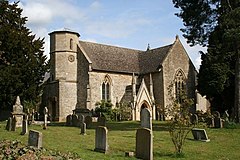Fyfield, Oxfordshire
| Fyfield | |
|---|---|
 St. Nicholas' parish church |
|
| Fyfield shown within Oxfordshire | |
| Population | 540 (parish, including Tubney) (2001 census) |
| OS grid reference | SU4298 |
| Civil parish | |
| District | |
| Shire county | |
| Region | |
| Country | England |
| Sovereign state | United Kingdom |
| Post town | Abingdon |
| Postcode district | OX13 |
| Dialling code | 01865 |
| Police | Thames Valley |
| Fire | Oxfordshire |
| Ambulance | South Central |
| EU Parliament | South East England |
| UK Parliament | |
Fyfield is a village in Fyfield and Tubney civil parish, about 4.5 miles (7 km) west of Abingdon. It was part of Berkshire until the 1974 boundary changes transferred it to Oxfordshire. The village used to be on the main A420 road between Oxford and Faringdon, but a bypass now carries the main road just south of the village.
Fyfield's toponym is derived from the Old English Fif Hide (10th century). It was spelt Fifhide from the 10th to the 16th century, but also Fivehide in the 11th century, Fifide from the 13th to the 15th century, Fifhede in the 15th century and Fighfield or Fyfylde in the 16th century.
There has been a manor of Fyfield since at least the 10th century. The Chronicle of Abingdon claims that in AD 956 King Eadwig granted his thegn Æthelnoth 13 manses of land there. In AD 968 King Edgar confirmed these 11 hides of land plus another 12 hides to the Benedictine Abingdon Abbey. After the Norman Conquest the manor was granted to Henry de Ferrers. In the 15th century the manor was held by John Golafre, and later by John, Earl of Lincoln who died in 1487. The manor then passed to the Crown. It was granted for life to Lady Catherine Gordon, the widow of the pretender Perkin Warbeck,who married Christopher Ashton and came to Fyfield in 1531. In 1554 the remainder was granted to Sir Thomas White, who gave it to his new foundation of St John's College, Oxford, which has held it ever since.
...
Wikipedia

